2022 HYUNDAI ELANTRA HYBRID trailer
[x] Cancel search: trailerPage 10 of 529
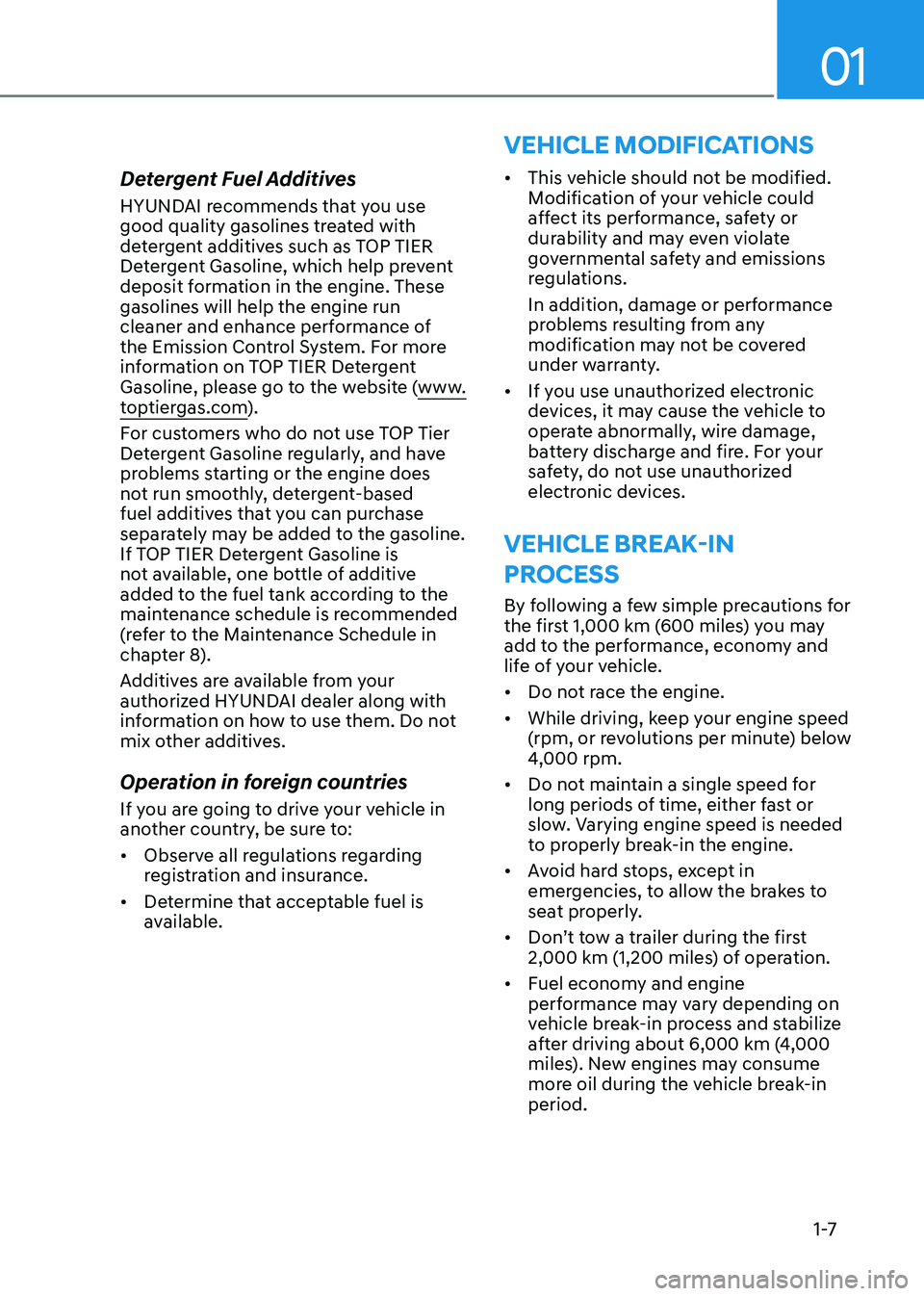
01
1 -7
Detergent Fuel Additives
HYUNDAI recommends that you use
good quality gasolines treated with
detergent additives such as TOP TIER
Detergent Gasoline, which help prevent
deposit formation in the engine. These gasolines will help the engine run
cleaner and enhance performance of
the Emission Control System. For more
information on TOP TIER Detergent
Gasoline, please go to the website (www.
toptiergas.com).
For customers who do not use TOP Tier
Detergent Gasoline regularly, and have
problems starting or the engine does
not run smoothly, detergent-based
fuel additives that you can purchase
separately may be added to the gasoline.
If TOP TIER Detergent Gasoline is
not available, one bottle of additive
added to the fuel tank according to the
maintenance schedule is recommended
(refer to the Maintenance Schedule in
chapter 8).
Additives are available from your
authorized HYUNDAI dealer along with
information on how to use them. Do not
mix other additives.
Operation in foreign countries
If you are going to drive your vehicle in
another country, be sure to: • Observe all regulations regarding
registration and insurance.
• Determine that acceptable fuel is
available. •
This vehicle should not be modified.
Modification of your vehicle could
affect its performance, safety or
durability and may even violate
governmental safety and emissions
regulations.
In addition, damage or performance
problems resulting from any
modification may not be covered
under warranty.
• If you use unauthorized electronic
devices, it may cause the vehicle to
operate abnormally, wire damage,
battery discharge and fire. For your
safety, do not use unauthorized
electronic devices.
Vehicle Break-in
Process
By following a few simple precautions for
the first 1,000 km (600 miles) you may
add to the performance, economy and
life of your vehicle. • Do not race the engine.
• While driving, keep your engine speed
(rpm, or revolutions per minute) below
4,000 rpm.
• Do not maintain a single speed for
long periods of time, either fast or
slow. Varying engine speed is needed
to properly break-in the engine.
• Avoid hard stops, except in
emergencies, to allow the brakes to
seat properly.
• Don’t tow a trailer during the first
2,000 km (1,200 miles) of operation.
• Fuel economy and engine
performance may vary depending on
vehicle break-in process and stabilize
after driving about 6,000 km (4,000
miles). New engines may consume
more oil during the vehicle break-in period.
VeHIcle ModIfIcAtIons
Page 247 of 529
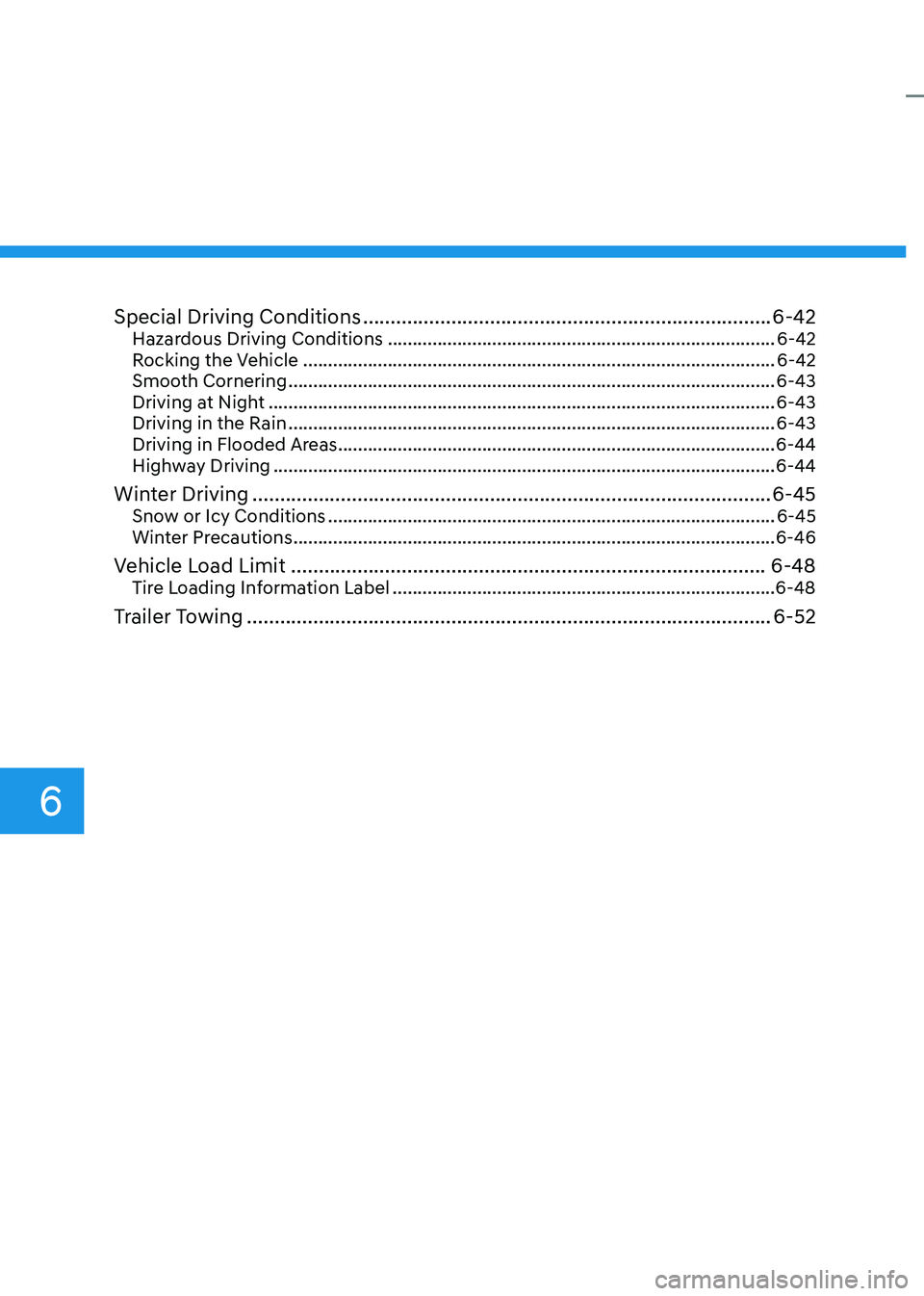
Special Driving Conditions .......................................................................... 6-42
Hazardous Driving Conditions .............................................................................. 6-42
Rocking the Vehicle ............................................................................................... 6-42
Smooth Cornering .................................................................................................. 6-43
Driving at Night ...................................................................................................... 6-43
Driving in the Rain .................................................................................................. 6-43
Driving in Flooded Areas ........................................................................................ 6-44
Highway Driving ..................................................................................................... 6-44
Winter Driving .............................................................................................. 6-45
Snow or Icy Conditions .......................................................................................... 6-45
Winter Precautions ................................................................................................. 6-46
Vehicle Load Limit ...................................................................................... 6-48
Tire Loading Information Label ............................................................................. 6-48
Trailer Towing ............................................................................................... 6-52
6
Page 293 of 529
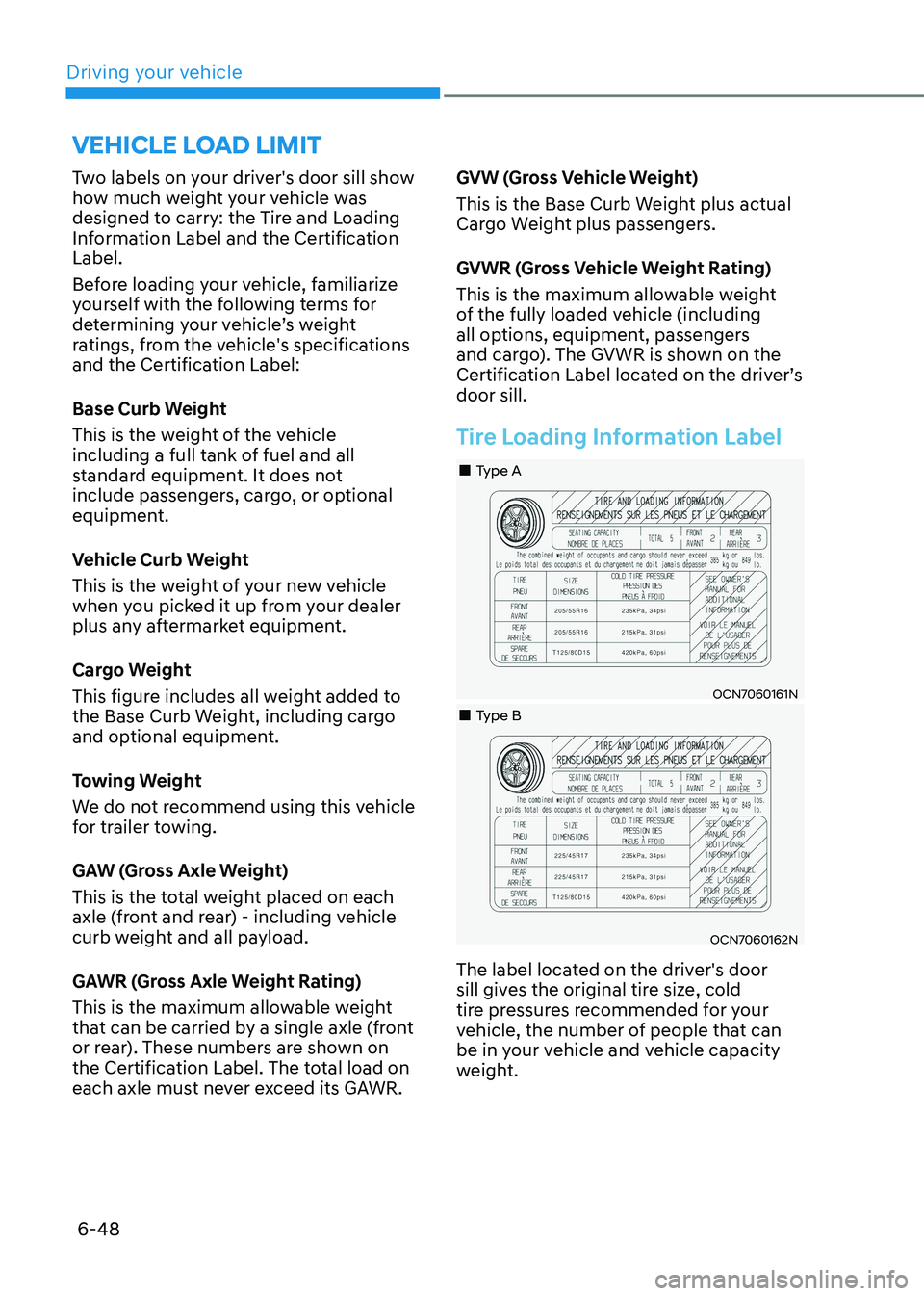
Driving your vehicle
6-48
Two labels on your driver's door sill show
how much weight your vehicle was
designed to carry: the Tire and Loading
Information Label and the Certification Label.
Before loading your vehicle, familiarize
yourself with the following terms for
determining your vehicle’s weight
ratings, from the vehicle's specifications
and the Certification Label:
Base Curb Weight
This is the weight of the vehicle
including a full tank of fuel and all
standard equipment. It does not
include passengers, cargo, or optional
equipment.
Vehicle Curb Weight
This is the weight of your new vehicle
when you picked it up from your dealer
plus any aftermarket equipment.
Cargo Weight
This figure includes all weight added to
the Base Curb Weight, including cargo
and optional equipment.
Towing Weight
We do not recommend using this vehicle
for trailer towing.
GAW (Gross Axle Weight)
This is the total weight placed on each
axle (front and rear) - including vehicle
curb weight and all payload.
GAWR (Gross Axle Weight Rating)
This is the maximum allowable weight
that can be carried by a single axle (front
or rear). These numbers are shown on
the Certification Label. The total load on
each axle must never exceed its GAWR.
GVW (Gross Vehicle Weight)
This is the Base Curb Weight plus actual
Cargo Weight plus passengers.
GVWR (Gross Vehicle Weight Rating)
This is the maximum allowable weight
of the fully loaded vehicle (including
all options, equipment, passengers
and cargo). The GVWR is shown on the
Certification Label located on the driver’s door sill.
Tire Loading Information Label
•„Type A
OCN7060161N
•„Type B
OCN7060162N
The label located on the driver's door
sill gives the original tire size, cold
tire pressures recommended for your
vehicle, the number of people that can
be in your vehicle and vehicle capacity
weight.
vehicle loaD limit
Page 294 of 529
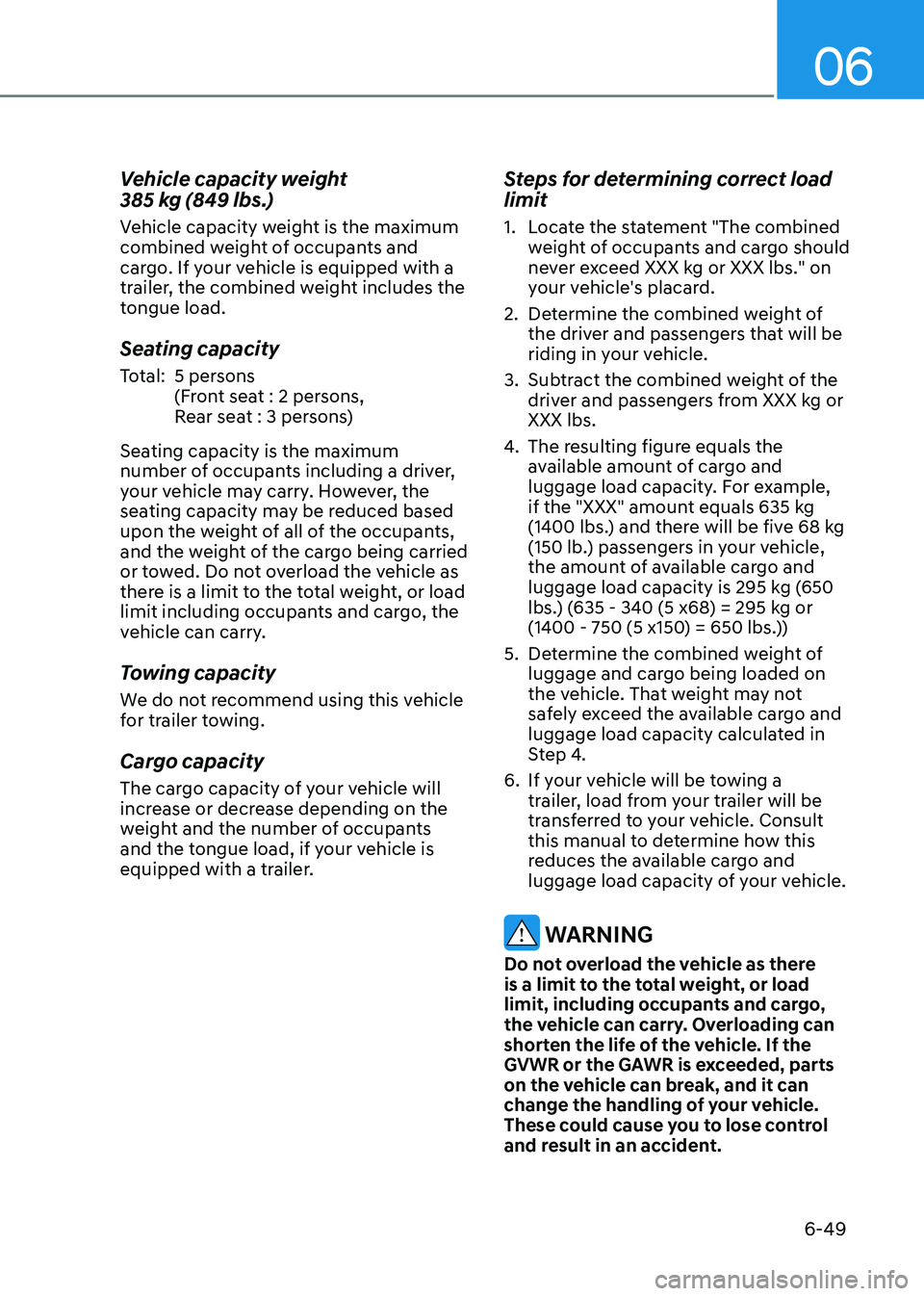
06
6-49
Vehicle capacity weight
385 kg (849 lbs.)
Vehicle capacity weight is the maximum
combined weight of occupants and
cargo. If your vehicle is equipped with a
trailer, the combined weight includes the
tongue load.
Seating capacity
Total: 5 persons
(Front seat : 2 persons,
Rear seat : 3 persons)
Seating capacity is the maximum
number of occupants including a driver,
your vehicle may carry. However, the
seating capacity may be reduced based
upon the weight of all of the occupants,
and the weight of the cargo being carried
or towed. Do not overload the vehicle as
there is a limit to the total weight, or load
limit including occupants and cargo, the
vehicle can carry.
Towing capacity
We do not recommend using this vehicle
for trailer towing.
Cargo capacity
The cargo capacity of your vehicle will
increase or decrease depending on the
weight and the number of occupants
and the tongue load, if your vehicle is
equipped with a trailer. Steps for determining correct load limit
1. Locate the statement "The combined
weight of occupants and cargo should
never exceed XXX kg or XXX lbs." on
your vehicle's placard.
2. Determine the combined weight of the driver and passengers that will be
riding in your vehicle.
3. Subtract the combined weight of the driver and passengers from XXX kg or XXX lbs.
4. The resulting figure equals the
available amount of cargo and
luggage load capacity. For example,
if the "XXX" amount equals 635 kg
(1400 lbs.) and there will be five 68 kg
(150 lb.) passengers in your vehicle,
the amount of available cargo and
luggage load capacity is 295 kg (650
lbs.) (635 - 340 (5 x68) = 295 kg or
(1400 - 750 (5 x150) = 650 lbs.))
5. Determine the combined weight of luggage and cargo being loaded on
the vehicle. That weight may not
safely exceed the available cargo and
luggage load capacity calculated in
Step 4.
6. If your vehicle will be towing a trailer, load from your trailer will be
transferred to your vehicle. Consult
this manual to determine how this
reduces the available cargo and
luggage load capacity of your vehicle.
WARNING
Do not overload the vehicle as there
is a limit to the total weight, or load
limit, including occupants and cargo,
the vehicle can carry. Overloading can
shorten the life of the vehicle. If the
GVWR or the GAWR is exceeded, parts
on the vehicle can break, and it can
change the handling of your vehicle.
These could cause you to lose control
and result in an accident.
Page 296 of 529
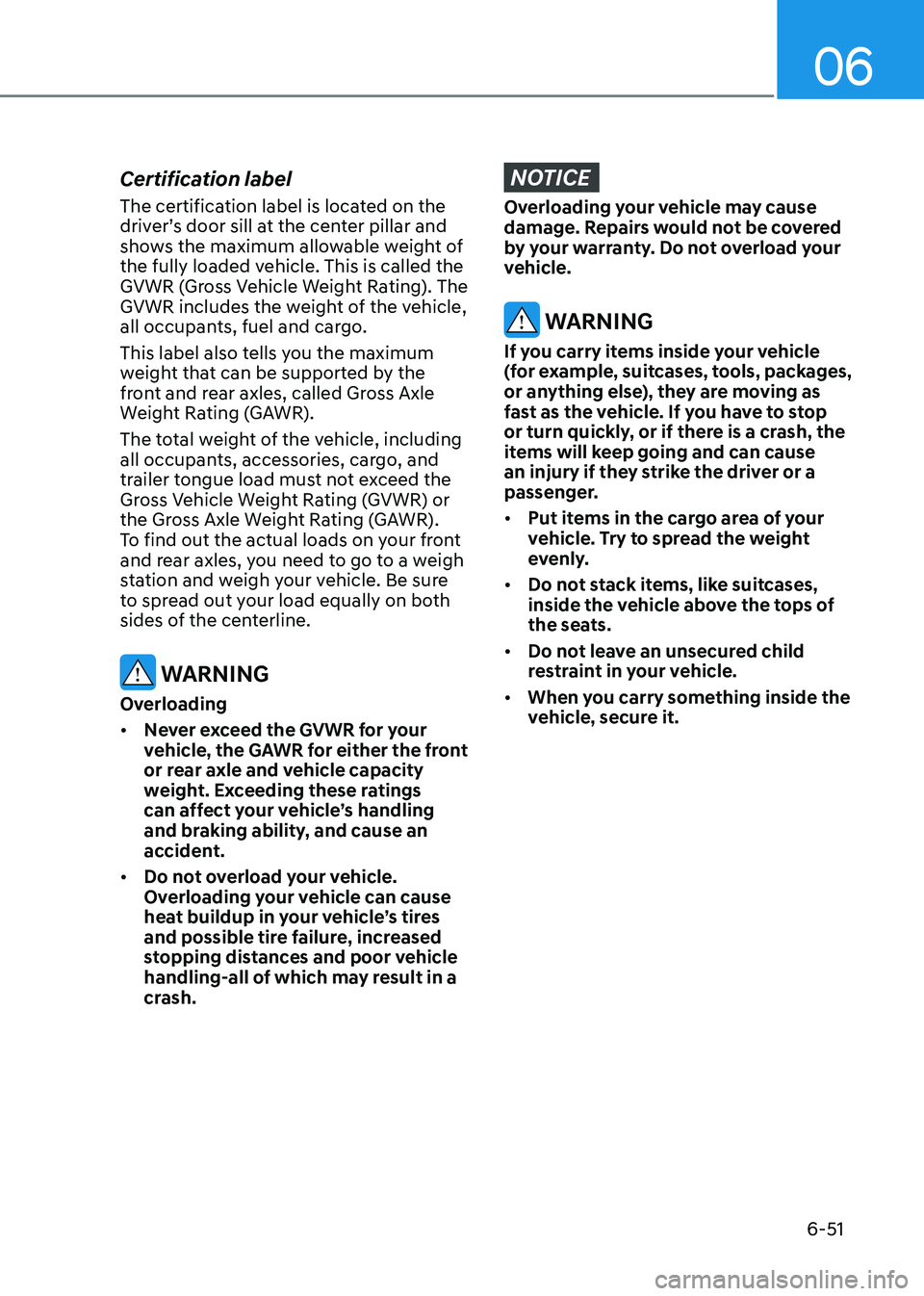
06
6-51
Certification label
The certification label is located on the
driver’s door sill at the center pillar and
shows the maximum allowable weight of
the fully loaded vehicle. This is called the
GVWR (Gross Vehicle Weight Rating). The
GVWR includes the weight of the vehicle,
all occupants, fuel and cargo.
This label also tells you the maximum
weight that can be supported by the
front and rear axles, called Gross Axle
Weight Rating (GAWR).
The total weight of the vehicle, including
all occupants, accessories, cargo, and
trailer tongue load must not exceed the
Gross Vehicle Weight Rating (GVWR) or
the Gross Axle Weight Rating (GAWR).
To find out the actual loads on your front
and rear axles, you need to go to a weigh
station and weigh your vehicle. Be sure
to spread out your load equally on both
sides of the centerline.
WARNING
Overloading • Never exceed the GVWR for your
vehicle, the GAWR for either the front
or rear axle and vehicle capacity
weight. Exceeding these ratings
can affect your vehicle’s handling
and braking ability, and cause an
accident.
• Do not overload your vehicle.
Overloading your vehicle can cause
heat buildup in your vehicle’s tires
and possible tire failure, increased
stopping distances and poor vehicle
handling-all of which may result in a
crash.
NOTICE
Overloading your vehicle may cause
damage. Repairs would not be covered
by your warranty. Do not overload your
vehicle.
WARNING
If you carry items inside your vehicle
(for example, suitcases, tools, packages,
or anything else), they are moving as
fast as the vehicle. If you have to stop
or turn quickly, or if there is a crash, the
items will keep going and can cause
an injury if they strike the driver or a
passenger. • Put items in the cargo area of your
vehicle. Try to spread the weight
evenly.
• Do not stack items, like suitcases,
inside the vehicle above the tops of
the seats.
• Do not leave an unsecured child
restraint in your vehicle.
• When you carry something inside the
vehicle, secure it.
Page 297 of 529
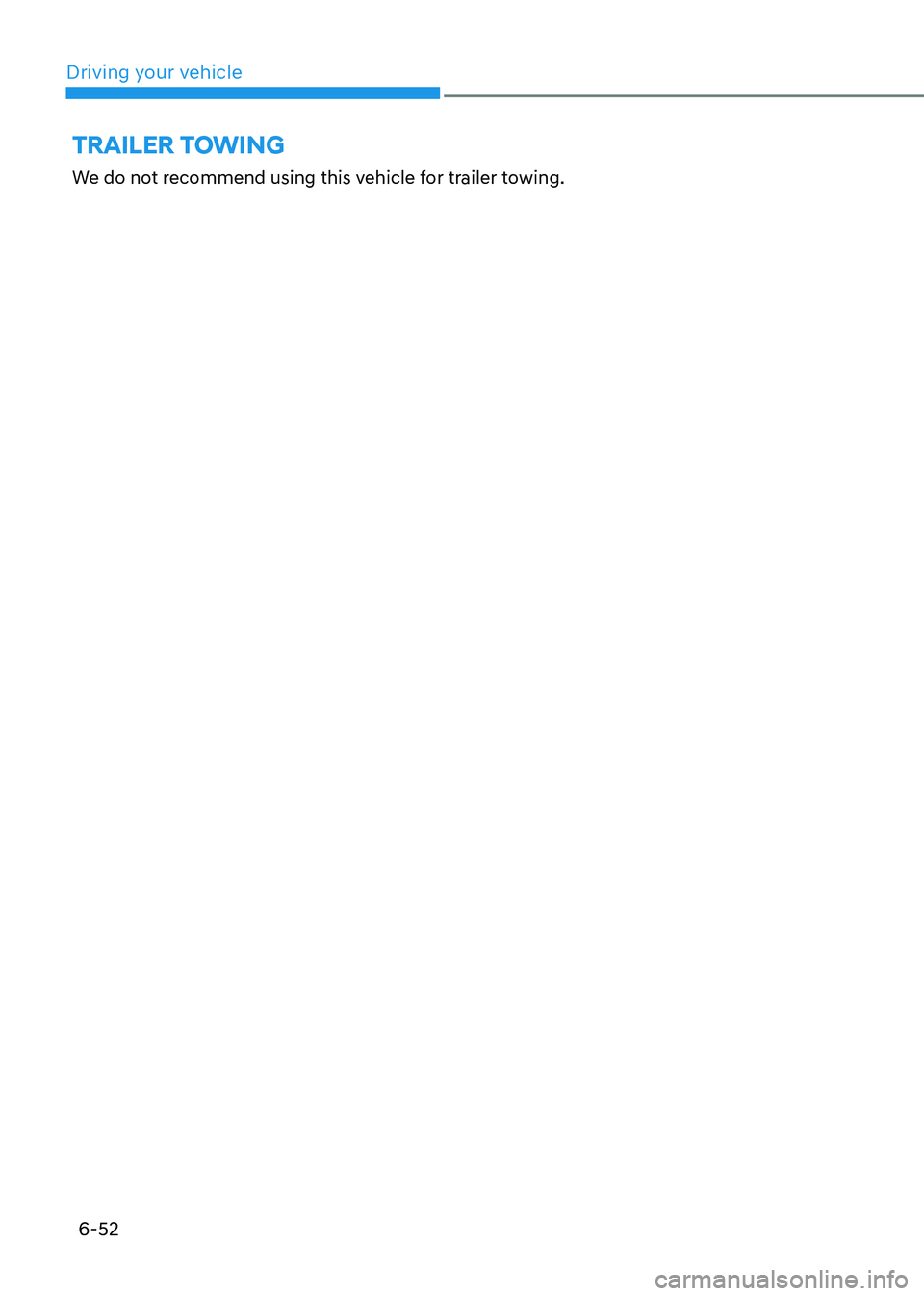
Driving your vehicle
6-52
We do not recommend using this vehicle for trailer towing.
trailer towing
Page 306 of 529
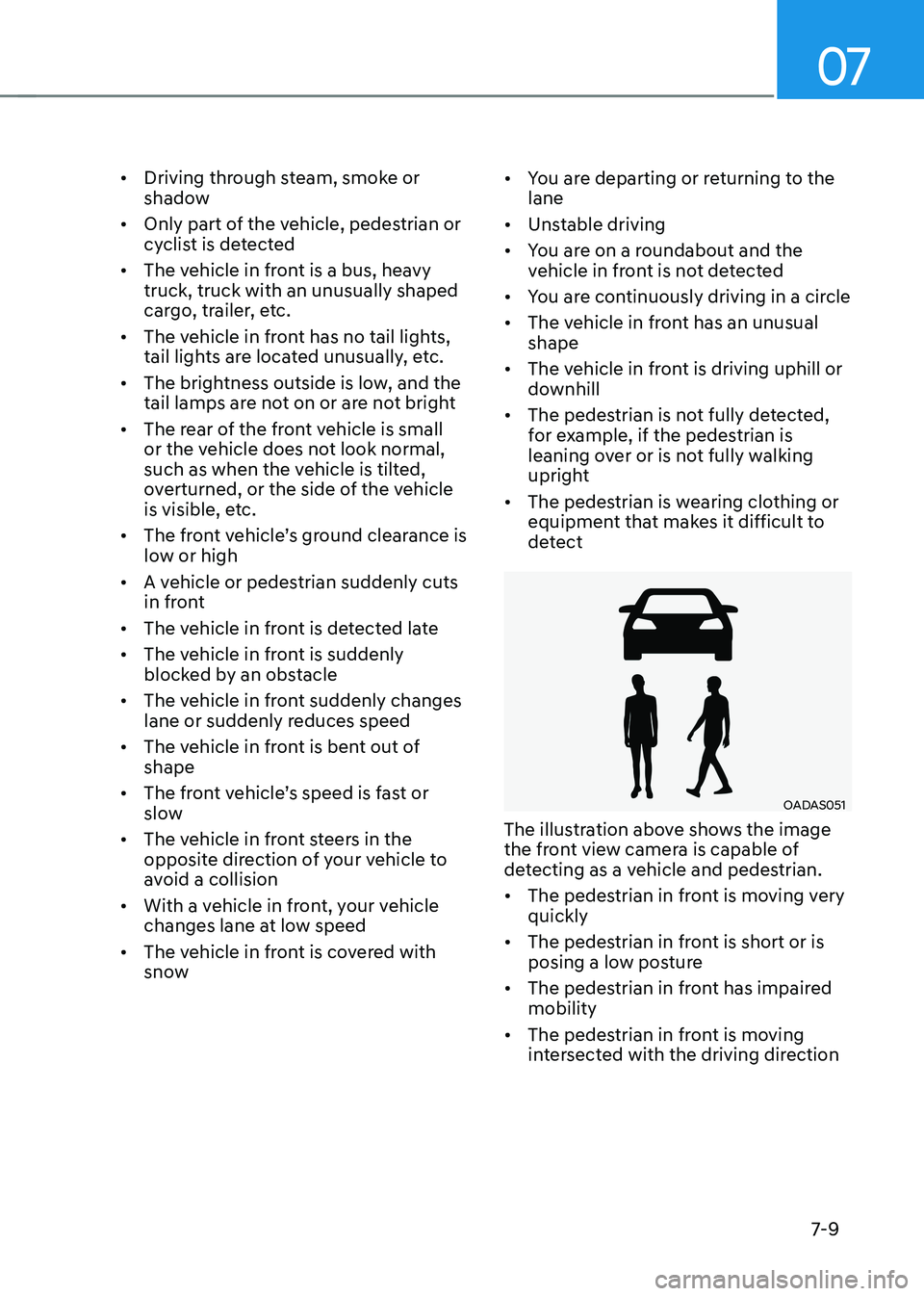
07
7-9
•
Driving through steam, smoke or
shadow
• Only part of the vehicle, pedestrian or
cyclist is detected
• The vehicle in front is a bus, heavy truck, truck with an unusually shaped
cargo, trailer, etc.
• The vehicle in front has no tail lights,
tail lights are located unusually, etc.
• The brightness outside is low, and the
tail lamps are not on or are not bright
• The rear of the front vehicle is small
or the vehicle does not look normal,
such as when the vehicle is tilted,
overturned, or the side of the vehicle
is visible, etc.
• The front vehicle’s ground clearance is low or high
• A vehicle or pedestrian suddenly cuts
in front
• The vehicle in front is detected late
• The vehicle in front is suddenly
blocked by an obstacle
• The vehicle in front suddenly changes
lane or suddenly reduces speed
• The vehicle in front is bent out of shape
• The front vehicle’s speed is fast or slow
• The vehicle in front steers in the
opposite direction of your vehicle to
avoid a collision
• With a vehicle in front, your vehicle
changes lane at low speed
• The vehicle in front is covered with
snow •
You are departing or returning to the lane
• Unstable driving
• You are on a roundabout and the
vehicle in front is not detected
• You are continuously driving in a circle
• The vehicle in front has an unusual shape
• The vehicle in front is driving uphill or
downhill
• The pedestrian is not fully detected,
for example, if the pedestrian is
leaning over or is not fully walking
upright
• The pedestrian is wearing clothing or
equipment that makes it difficult to
detect
OADAS051
The illustration above shows the image
the front view camera is capable of
detecting as a vehicle and pedestrian. • The pedestrian in front is moving very quickly
• The pedestrian in front is short or is
posing a low posture
• The pedestrian in front has impaired mobility
• The pedestrian in front is moving
intersected with the driving direction
Page 310 of 529
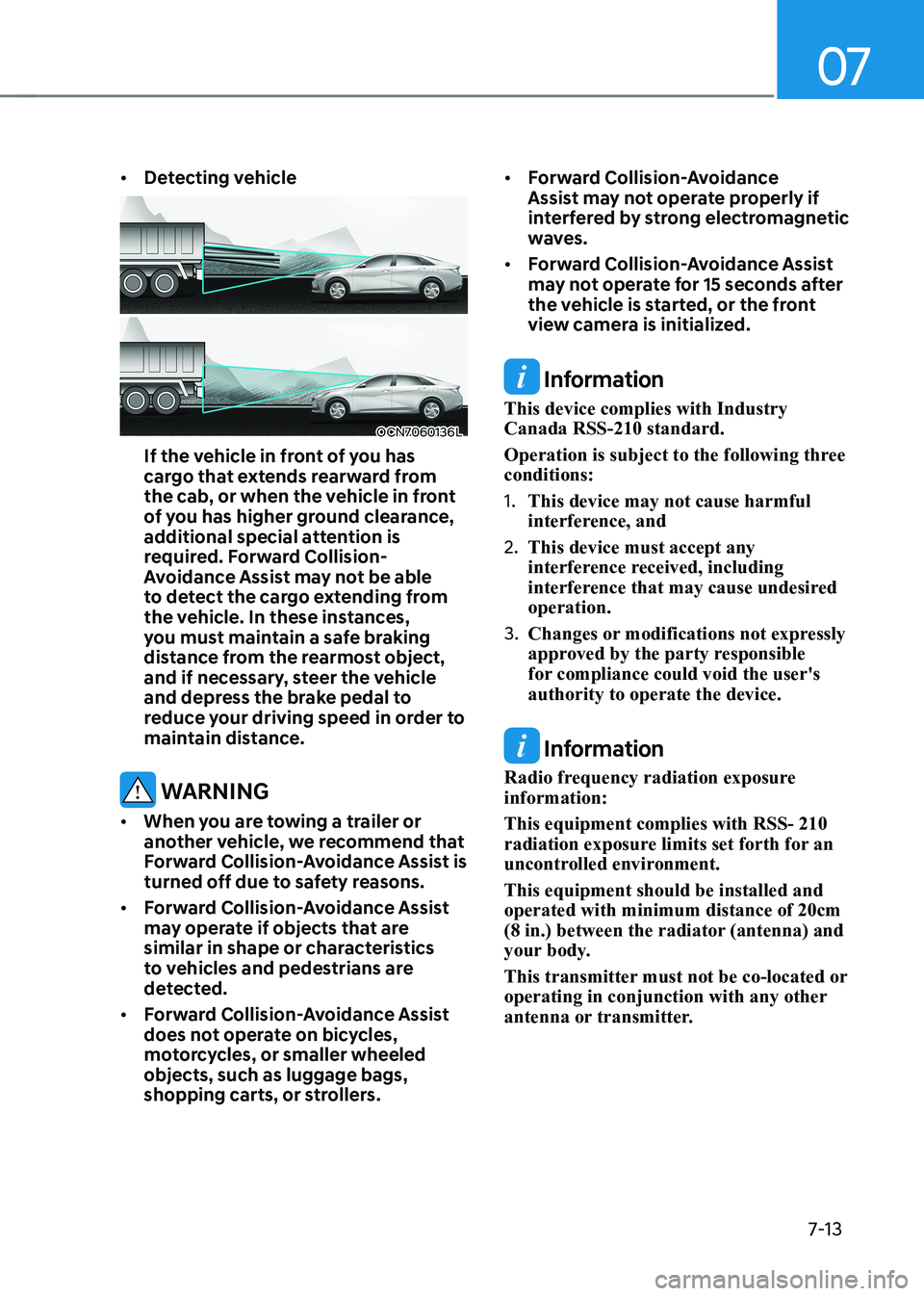
07
7-13
•
Detecting vehicle
OCN7060136L
If the vehicle in front of you has
cargo that extends rearward from
the cab, or when the vehicle in front
of you has higher ground clearance,
additional special attention is
required. forward Collision-
Avoidance Assist may not be able
to detect the cargo extending from
the vehicle. In these instances,
you must maintain a safe braking
distance from the rearmost object,
and if necessary, steer the vehicle
and depress the brake pedal to
reduce your driving speed in order to
maintain distance.
WARNINg
• When you are towing a trailer or
another vehicle, we recommend that
forward Collision-Avoidance Assist is
turned off due to safety reasons.
• forward Collision-Avoidance Assist
may operate if objects that are
similar in shape or characteristics
to vehicles and pedestrians are
detected.
• forward Collision-Avoidance Assist
does not operate on bicycles,
motorcycles, or smaller wheeled objects, such as luggage bags,
shopping carts, or strollers. •
forward Collision-Avoidance
Assist may not operate properly if
interfered by strong electromagnetic
waves.
• forward Collision-Avoidance Assist
may not operate for 15 seconds after
the vehicle is started, or the front
view camera is initialized.
Information
This device complies with Industry Canada RSS-210 standard.
Operation is subject to the following three conditions: 1. This device may not cause harmful
interference, and
2. This device must accept any
interference received, including
interference that may cause undesired operation.
3. Changes or modifications not expressly
approved by the party responsible
for compliance could void the user's authority to operate the device.
Information
Radio frequency radiation exposure information: This equipment complies with RSS- 210
radiation exposure limits set forth for an
uncontrolled environment. This equipment should be installed and operated with minimum distance of 20cm
(8 in.) between the radiator (antenna) and
your body.
This transmitter must not be co-located or
operating in conjunction with any other
antenna or transmitter.